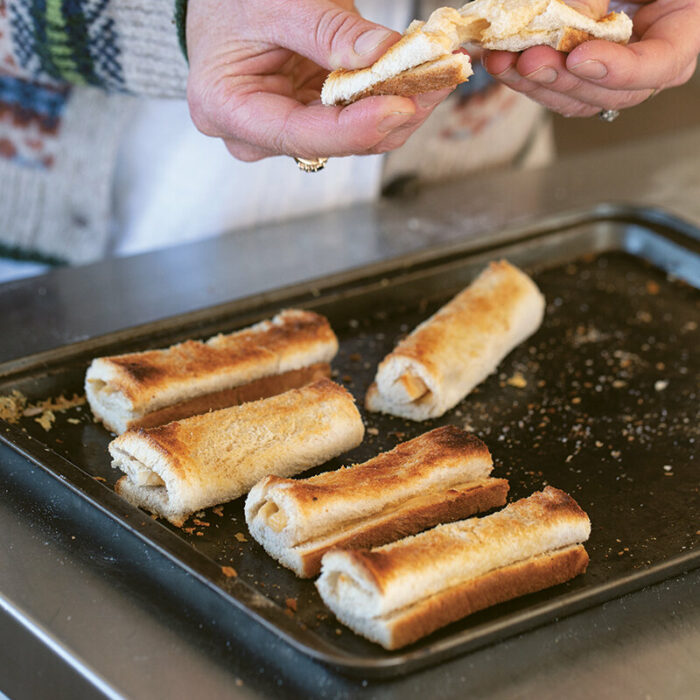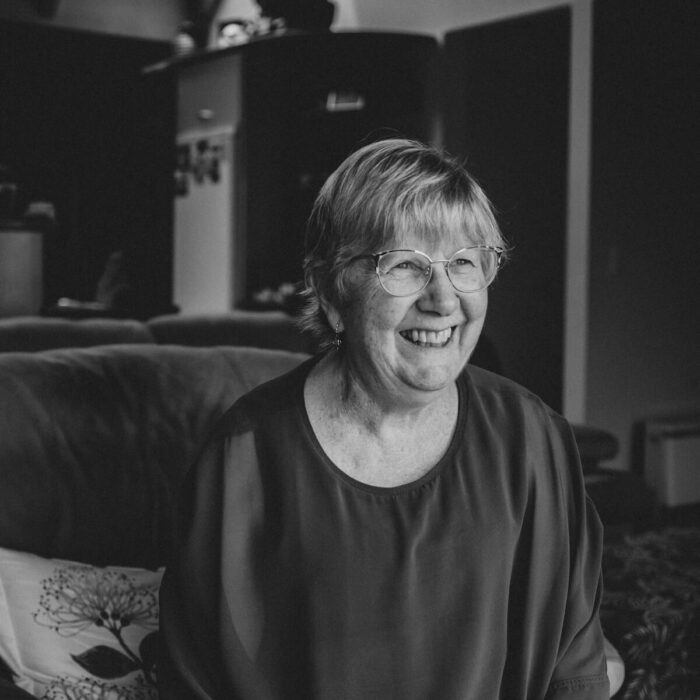13 March 2023
The Heart’s Road
WRITER: FELICITY CONNELL
PHOTOGRAPHER: MICHELLE HEPBURN
Ringatoi Ahuwhenua. Rural Creative.
Fleur Wickes is a Whanganui-based writer and artist, weaving together powerful, emotional words with her arresting – almost typographical – art style. For Fleur, art, emotion and balance are all interconnected, acting as both a release for her own feelings and as a way to connect with others around the world.

“I have a real belief that no matter who you are, all of us have had something we’ve had to deal with, trauma or disappointment or whatever it is,” Fleur says. “All of us have. You just scratch the surface of anyone’s life and there’s really tough stuff there.”
Prominent in Fleur Wickes’ office is a large artwork that declares I am an emotionalist. Like a manifesto of sorts, the phrase is typical of her work – poetic, profound and playful. “I’ve got this thing with my work,” Fleur says. “I prefer it to be quite big. These emotions that we have, supposedly they need to be private and quiet. I like them to be large, because they’re important. We often talk about momentous collective events, but those little moments we have in our personal lives are just as important. I have this necessary thing to release my big emotions. And if I can’t put them somewhere, it doesn’t go well for me,” she adds with a laugh.
While her work is intensely personal, Fleur keeps specifics from her life out of the pieces. “I’m not sharing details of my private life; it’s the feeling of it, it’s my emotional self that I’m revealing. It’s a relief and a release for me, and it’s not hard; it’s helpful. It’s just the ordinary human emotions I talk about – love, grief, sadness, trauma. I’ve had plenty of the tough things, but also a huge amount of love. It’s always interesting to me how grief and the really happy things are quite often intertwined.”
For Fleur, images and words – both in the artwork itself and how she talks about her art – all go together. “It’s not that the images can’t stand alone, because they can, and they do. But somehow the words that I write, and the story that I say, reinforces the imagery. It’s hard to explain because it’s something very instinctual, but the words I say about the artwork are somehow part of the work. That’s why I talk about my work a lot on social media or in my newsletter. People who buy my artwork, or connect with it – it’s an emotional thing, even if their story or the meaning they place on the artwork is really different to mine,” she says. “Someone recently sent me a photo of where they had hung one of my artworks in their home. I loved that the work is living as part of their life and has meaning to them. That’s why I do the work I do, because it has meaning to people outside of me completely.”


People often get in contact to share with Fleur why they buy her work and what it means to them. “One woman bought It’s a hard road. It’s a heart’s road, it must have gone down if we feel alive for her grandson who had just had heart surgery. Another woman contacted me from Australia – I didn’t know her at all – she’d followed me on social media and bought some of my work. She’d just been given a terminal diagnosis, and she wanted to tell me why this particular work was so meaningful to her. It’s a privilege to receive that kind of response.”
After living and working in Wellington for many years, Whanganui – where Fleur spent much of her childhood – is once again her creative base. “When I was a teenager, my parents bought and ran a pub here, so I went to secondary school in Whanganui. I actually quite loved living here then, even though it was brutal at times. I learned some huge life lessons around violence and all sorts of tough things at the pub,” she says. “I still love Wellington and spend time there, but coming back to Whanganui is always lovely. It’s quiet and gentle – it’s like a warm bath. The quietness gives me the space to create, and – because it’s cheaper to live here – it was a good base to re-establish myself.”
Following teenage ambitions to be a doctor, Fleur decided at eighteen she would make her living from art and business. Moving to Wellington to study photography at what was then Wellington Polytechnic, at nineteen she made her first attempt at running her own photography business, but it didn’t succeed. In the early nineties, while working out her next steps, she did Bill Manhire’s creative writing course at Victoria University of Wellington. While there, she was given advice that has resonated throughout her career. “Bill told me the more specific that you can make your work, the more universal it will be. And I’ve found that to be true.”

While she loved her foray into writing, she found her way back to photography. “I worked for another photographer for around five years. It enabled me to learn about business, and what I did and didn’t like. I saw a gap in the market in terms of photographic portraiture and did that for around twenty years.”
On the surface, everything had seemed to fall into place, and she was fulfilling her ambition to make a living from being creative. “In my thirties I had the outward signs of success – I was married, had a family and a great house. I was flying around the country and earning good money from my portraiture business. Despite all the external accolades, I felt like a loser and really sad most of the time. Then my marriage broke down, and I was raising my young son by myself. I still pushed all the difficult stuff – the trauma – away for a really long time. Then in my late thirties, I had this day where it was just like a tsunami and I could not stop it anymore. For about six months after that, I was a wreck. I used to walk my son to school, come back, go to bed and only get up when he came home.”
It took therapy, a change of location and a change of artistic direction to start the process of healing. “Doing therapy helped me do a deep-dive in the connections from the past, and why I felt so sad and so shit. Around the same time, I decided to step away from the portraiture work. It was going well financially but I’d got to the stage where I didn’t have anything more to say artistically. I was invited to teach a course in Whanganui and fell back in love in the place. When I moved back to Whanganui, I was on the bones of my arse for four or five years. I had to strip myself back both financially and emotionally. My focus became looking after my son and myself and doing the necessary but challenging work to heal. From being completely broken apart internally, I slowly put myself together. I also started exploring text-based work. I’m not quite sure where that impulse came from. I’ve always loved words and I just started drawing them!”

Throughout it all, continuing to create was important. “My work – I held onto it, like, by my fingernails. My art has always been the thing that has held me. I’ve stayed in front of the fear and the terror because of it. I’ve always just been slightly more interested in making art than I have been in staying in how scared I was. I think the reason for the work is to take the tough stuff and find what’s beautiful. It’s equal and opposite and together at the same time. Almost right at the same moment that we have something really hard, we can find something really beautiful,” she says.
“I decided that my work was not going to be heavy, that the work was about the light, not the darkness. The piece I made called It's beautiful here in the light is really important to me. It’s the figure of a woman against a golden background. I found a photograph I’d taken of my own shadow a couple of years ago, and I made a woman’s figure over the shadow. Making the work, I had the realisation that I was in the f------ light. I still get goose bumps just thinking about it. I couldn’t believe that I got to be that person, that I get to live the life that I have now. I never even thought that I could. I didn’t think a person with the level of darkness that I had would ever be allowed to do that.”
At fifty-two, Fleur is in a good space. Her son, now an adult, is happy and independent. She is creating strong work and is in a loving, stable relationship. “My life is great now. But there’s still times where things are hard. My art,
my work and my words continue to be what’s getting me through. There is the business side of it, where I consciously try to make a living from what I do. But the artwork that I make, it’s just from me, because I need to make it. People feel that authenticity,” she says. While it’s been challenging, she is proud of everything she has achieved.
“It can be lonely, that hard road of coming to your own self – even if you have a partner beside you every step of the way – because you are the only one who can do it. It’s a hard road – the heart’s road, the road of the emotional self – but there’s nothing else more important because if that’s not sorted, then what else have you got? I refuse to let other people’s past behaviour against me dictate how I feel in my life. My whole adult life has been a refusal of that, and my work hopefully always has some sort of light. It’s a refusal to be in the dark.”



This story is part of THREAD, a year-long project by Shepherdess made possible thanks to the Public Interest Journalism Fund through NZ On Air.
If you enjoyed this story, please share with someone else.
This story appeared in the Ngahuru Autumn 2023 Edition of Shepherdess.
Get your hands on a copy.
Related Stories
Cheese Rolls
It seems every family has their own version of the classic South Island cheese roll.



